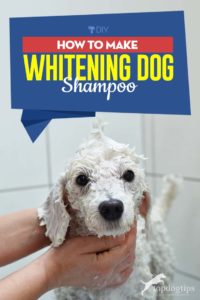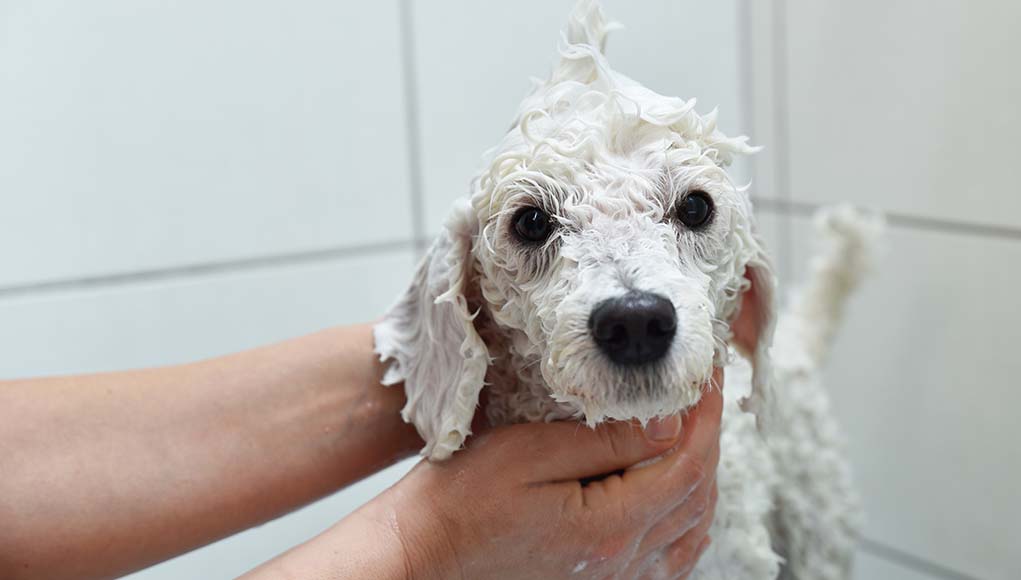We all know the power of white color. We dress in white to look appealing and make a good first impression. But, don’t you just hate that when you are all dressed up in white and before you know it, there is a stain from a coffee on your white wardrobe? It's a similar case with dogs and their white fur, which is where whitening dog shampoo comes in.
While white is a sensitive color to wear for people, it is even more difficult for dogs with white fur (or rather, for the owners of said breeds). And while they are adorable and worth the trouble, you will have to put some work into keeping your dog’s fur white. Let's talk about the power of a whitening shampoo for dogs and how to make it on your own.
Why and How Does Dog’s Fur Get Stained?
 The answer to this question is fairly simple – as people get dirty, so do dogs. However, if the dog has darker fur, he will look cleaner for a longer period of time, and it will be a while before you notice the stains on his fur.
The answer to this question is fairly simple – as people get dirty, so do dogs. However, if the dog has darker fur, he will look cleaner for a longer period of time, and it will be a while before you notice the stains on his fur.
After taking a walk with your white friend, take a close look at his fur. When you play around with him or when you let him go sniff the bushes or play with our dogs, he will easily catch dirt, mud or even paint from your neighbor’s freshly painted fence.
While some of these marks are fairly easy to remove and you can use just a soft piece of cloth and water, some will be a greater challenge.
Every once in a while, turn your dog on their back and you’ll notice that his belly or parts around his legs have got a bit yellowish. These are not even stains with visible boundaries, but simply layers of dust and mud which tarnish the perfect white color.
Is It Harming My Dog’s Health?
The simple answer is – no, although this is not always true.
Just because your dog’s fur turned a bit grey or white, doesn’t mean that he has some disease. If you are one of the people who don’t enjoy spending too much time bathing their dogs, there is nothing wrong with that. As long as you maintain a good level of hygiene, you can continue playing and rolling around with your pooch.
However, some stains may indicate that your dog’s hygiene is not properly maintained, and in this case, he can get an infection which can lead to disease, especially at the time when he has some wound like fly or flea bite or a scratch.
To be on the safe side, create a bathing schedule. For example, you can make a plan to clean your dog thoroughly once in two weeks, while every second day you will just go over his fur with wet wipes or cloth. Arranging this would give you the confidence that stains on your dog are there just because of the lack of whitening shampoo and not because of the hygiene.
If you ever notice red stains which look like blood drops, this can point to a more serious condition, especially if you cannot find the source of blood. This might be caused by a simple flea bite which is not visible in the long fur, but also can be the result of blood in your dog’s stool or urine in which case this needs to be checked.
In these situations, take your dog for a check-up at a local vet clinic, and they will advise you about the further steps.
Differences Between Whitening Dog Shampoos
 If you want to make sure that your dog’s fur is as clean and white as possible, find the perfect whitening shampoo that is suitable for your dog and you will be good to go.
If you want to make sure that your dog’s fur is as clean and white as possible, find the perfect whitening shampoo that is suitable for your dog and you will be good to go.
Whitening shampoos can be bought in pet stores and pharmacies or made at home from simple ingredients. The differences among shampoos are based on different compositions, and here are some of the most common ones:
Clarifying and Bleaching Dog Shampoos
They decompose stains, dirt and different types of matter caught in your dog’s fur. They are particularly good for stains which are difficult to remove only with water, like blood, resin or oil.
You need to be careful how often you use it and whether it is suitable for your dog since it has a high pH level of 3 to 4 which is close to your dog’s pH level of 6 to 7 and can cause irritation or damage to your dog’s skin and fur.
Bluing Dog Shampoos
They are used for emphasizing the whiteness of your dog’s fur. They manage to neutralize all other colors which tarnish your dog’s perfect white fur.
Bluing shampoos are not as aggressive as bleaching shampoos and your dog will be glowing when you invite the guests to your house.
Enzymatic Dog Shampoos
They are also efficient stain removers. They manage to dissolve various types of stains, although they might not be helpful enough when it comes to more stubborn stains like wax or oil.
In this case clarifying and bleaching shampoos would be more efficient. If you want to avoid them, use enzymatic shampoos more often, especially because they are fairly mild.
Dyeing Dog Shampoos
They are not intended for washing the stains but for covering them. If in general you maintain good hygiene of your dog, but want to avoid the shampoos which have stronger chemicals, like the ones mentioned above, you can use this to whiten your dog’s fur.
Bear in mind, that these whitening dog shampoos are intended for aesthetic purposes and not for hygiene. You would need to use a regular dog shampoo before this one. Dyeing shampoos cannot replace shampoos which you use when bathing your dog.
RELATED: How to Remove Stains from White Dog Fur
How to Make Whitening Dog Shampoo
If you don’t like any of these ideas, or you simply prefer natural products, here are the instructions for making a perfect whitening shampoo for dogs using simple ingredients.
Prepare one empty bottle, and make sure to wash it thoroughly before you start mixing the ingredients. It is better to take a larger bottle, then to realize later that you don’t have enough space for all the ingredients.
Put around 1dl of regular dish soap. Choose the fragrance which you prefer – flowers, olive oil, lemon, passion fruit, because your shampoo will take over the fragrance of the dish washer.
Add 2 dl of vinegar to the mixture. Choose light, natural vinegar, like apple cider. Avoid types of vinegar with too intense smells because your dog might not like it and start avoiding bathing just because of the strong smell.
Don’t forget to add 2dl of water to your shampoo, otherwise, it can be too strong. When it comes to water, it is better to put a bit more than a bit less.
Buy laundry bluing that people use for bleaching their clothes. You can find it in supermarkets or online. This magic-making liquid consists of Prussian blue (ferric ferrocyanide) and water and it is enough to put 2 tablespoons of bluing into your shampoo.
Shake your whitening shampoo until it becomes homogenous and schedule the next bathing time with your pet. Remember to always shake the bottle before using the shampoo as the liquids are of different density and they will form separate layers in the bottle when the mixture settles down.
Where to Buy Whitening Shampoo for Dogs
If, after reading these instructions on how to make whitening dog shampoo, you decide that this may be too much trouble, you can always purchase a commercial whitening shampoo for dogs that is safe and effective. There are several brands that make quality shampoos, but these three below are the best ones so far:
| Preview | Product | Rating | |
|---|---|---|---|

|
Wahl USA Whitening Shampoo White Pear scent for... | 4,741 Reviews | Check Price |

|
Seamus Pina Colada Professional Hypoallergenic,... | 618 Reviews | Check Price |

|
BioSilk for Dogs Silk Therapy Whitening Shampoo |... | 5,342 Reviews | Check Price |
When to Avoid Whitening Shampoo for Dogs
Even though whitening shampoos seem like a solution to our dog’s tints and stains, there are circumstances which should be taken into account before deciding to use it:
If your dog is a puppy his skin can be too sensitive even for home-made whitening shampoos. Puppies have softer skin and thinner fur, and using chemicals like dish soap can be irritating for their skin. If your dog has a bad reaction to it, stop using the whitening shampoo and consult with a vet if you should continue using it. He might suggest quitting it altogether or switching to the softer versions created specifically for young dogs.
If your dog already has some sore place like a bite wound or scratch mark which is still bleeding, consider avoiding this shampoo, especially bleachers, until he heals properly.
If your dog has sensitive skin in general and is prone to skin irritations, you can look for commercial dog shampoos for sensitive skin.
If your dog has too dry skin, these shampoos can cause additional dryness which can lead to skin rash. In this situation, you can either add moisturizer to the shampoo, or use it immediately after the bath.
In Summary
 Having a dog with white fur is a blessing and a curse. They are extremely cute, but at the same time more difficult for maintaining, and this is when whitening dog shampoos jump in.
Having a dog with white fur is a blessing and a curse. They are extremely cute, but at the same time more difficult for maintaining, and this is when whitening dog shampoos jump in.
There are many commercial versions with different ingredients, but one of the best options is to make it yourself. The process is very simple and the final product doesn’t contain any substances which can be harmful to your dog.
However, bear in mind that there are situations when you should avoid using it or switch to a different product. When in doubt, always consult the vet.
READ NEXT: Dog Fur Dye – What You Must Know About It
Disclosure: We may earn affiliate commissions at no cost to you from the links on this page. This did not affect our assessment of products. Read more here and find full disclosure here.













